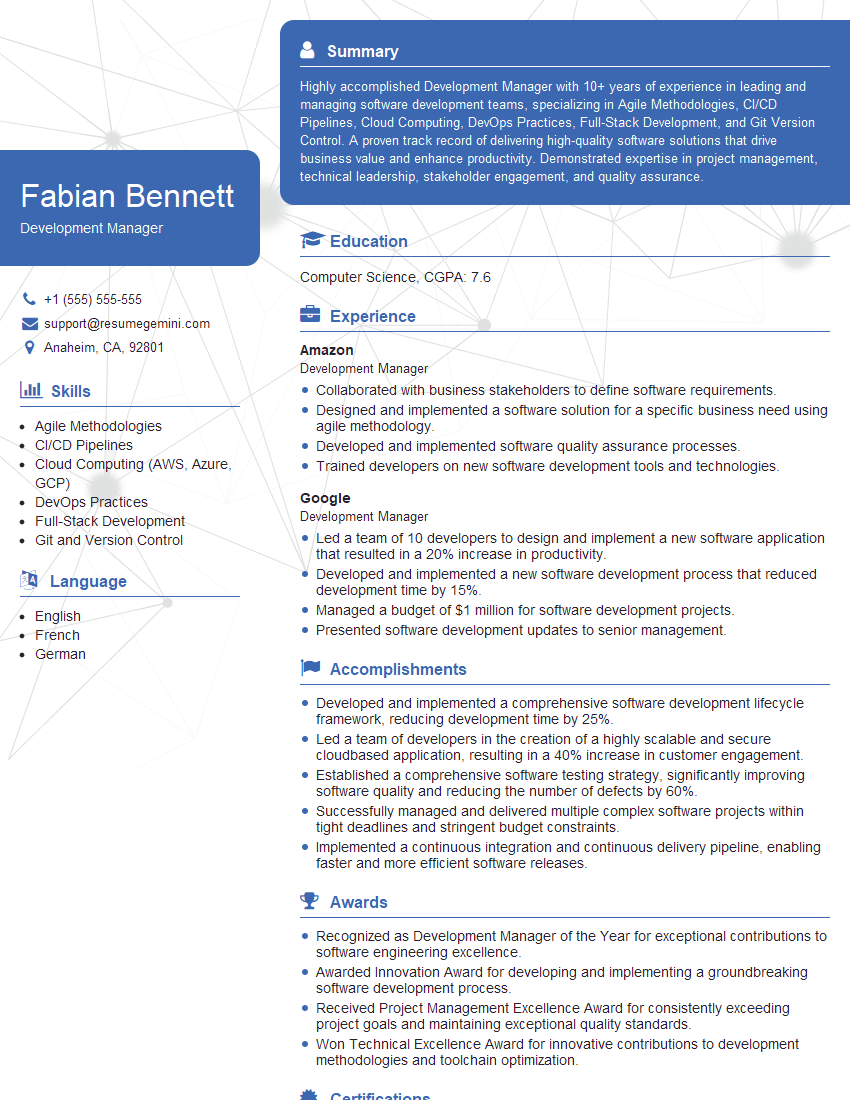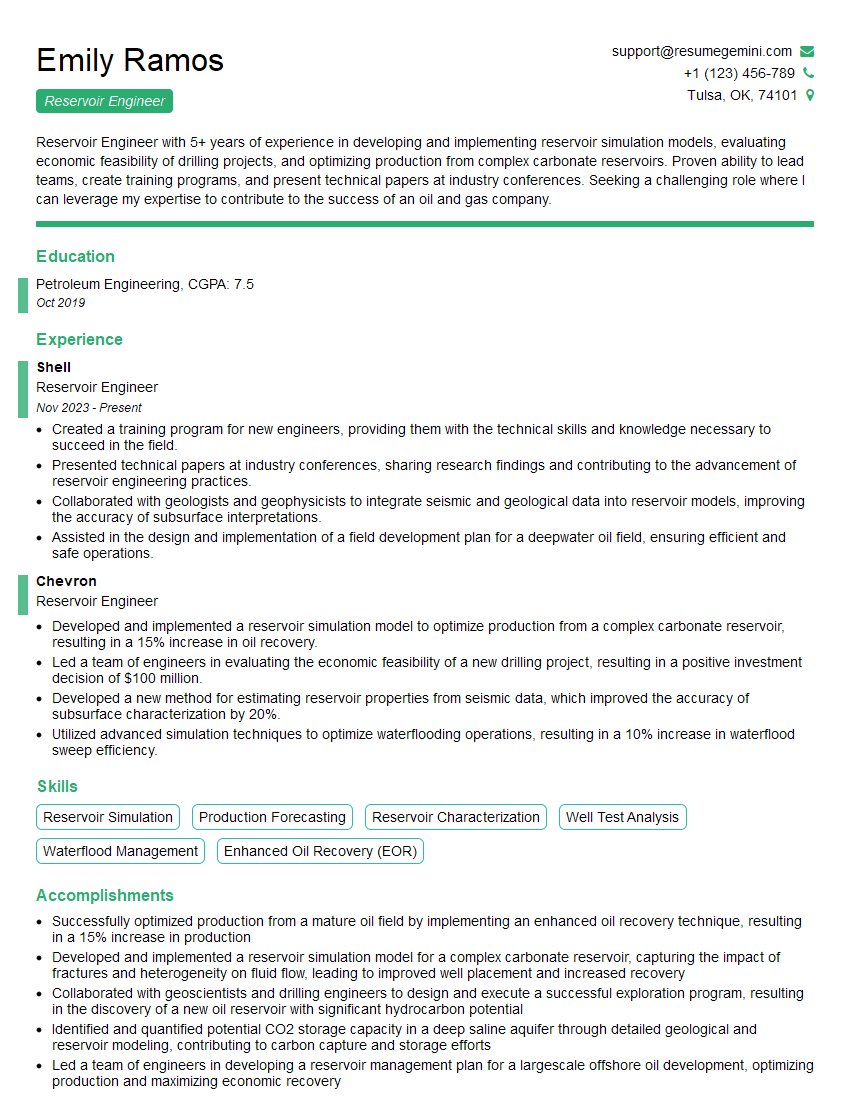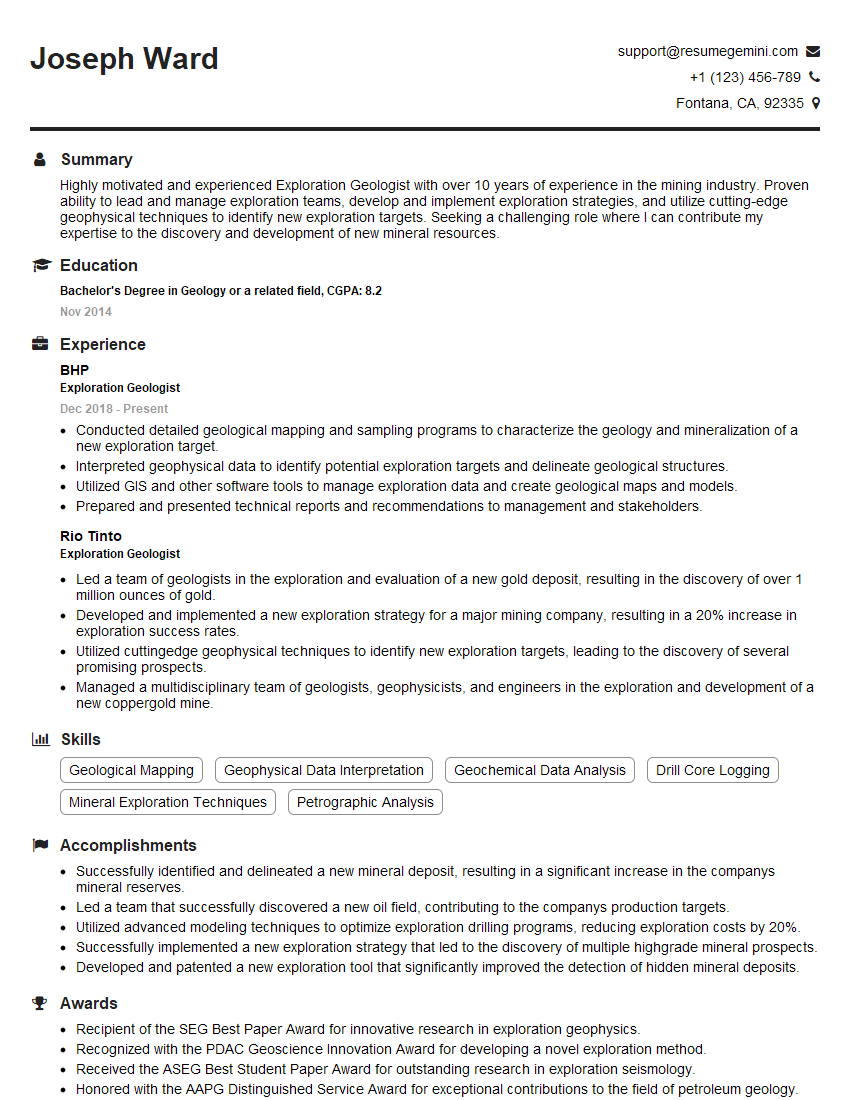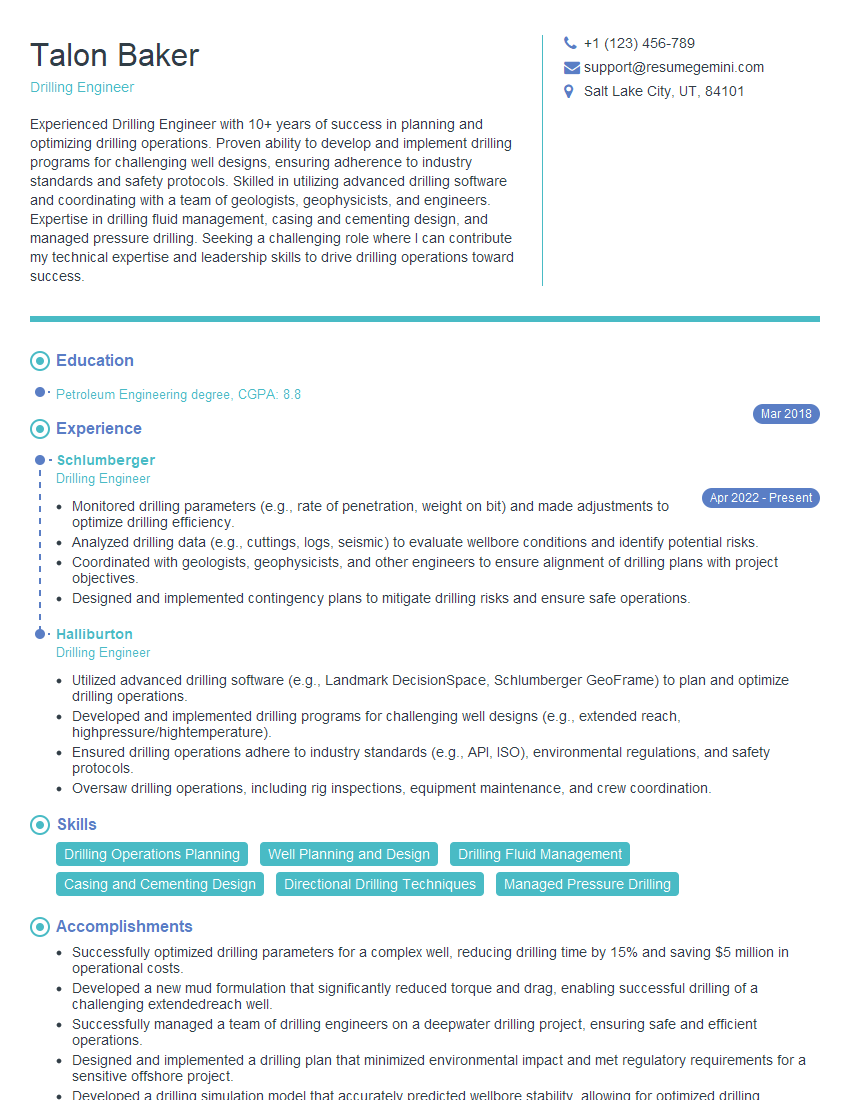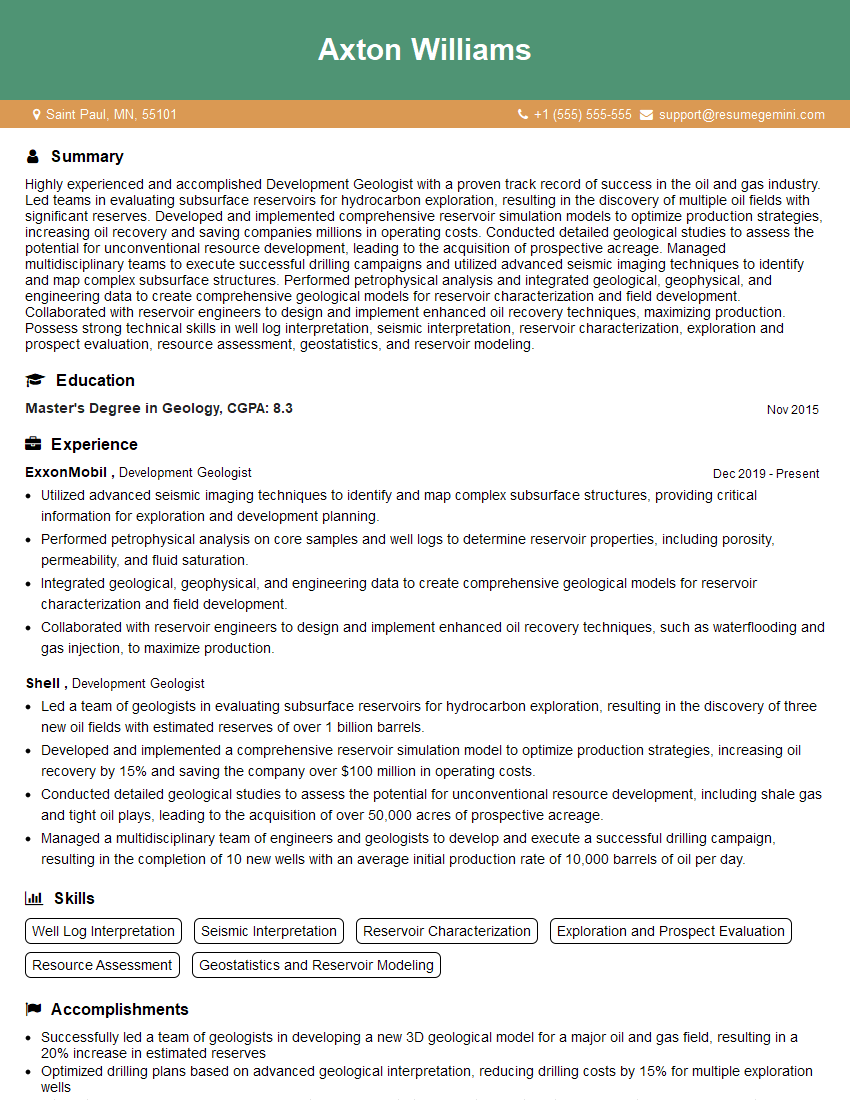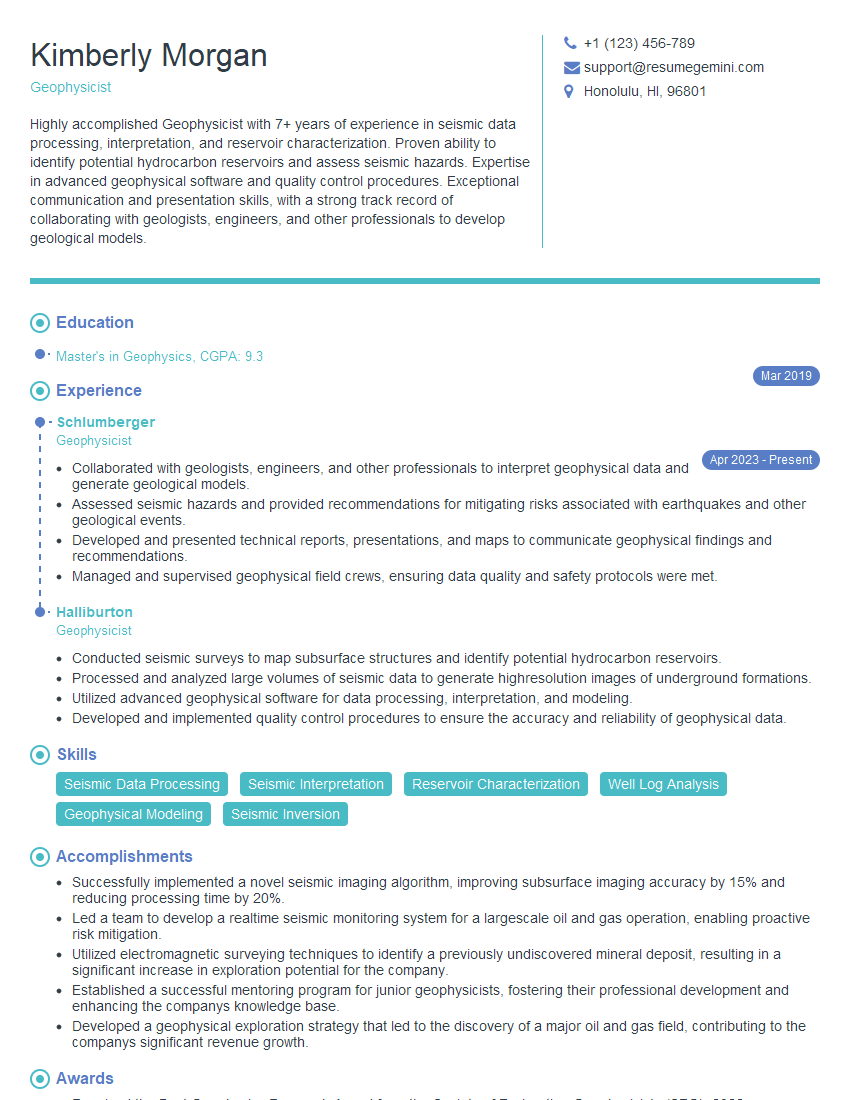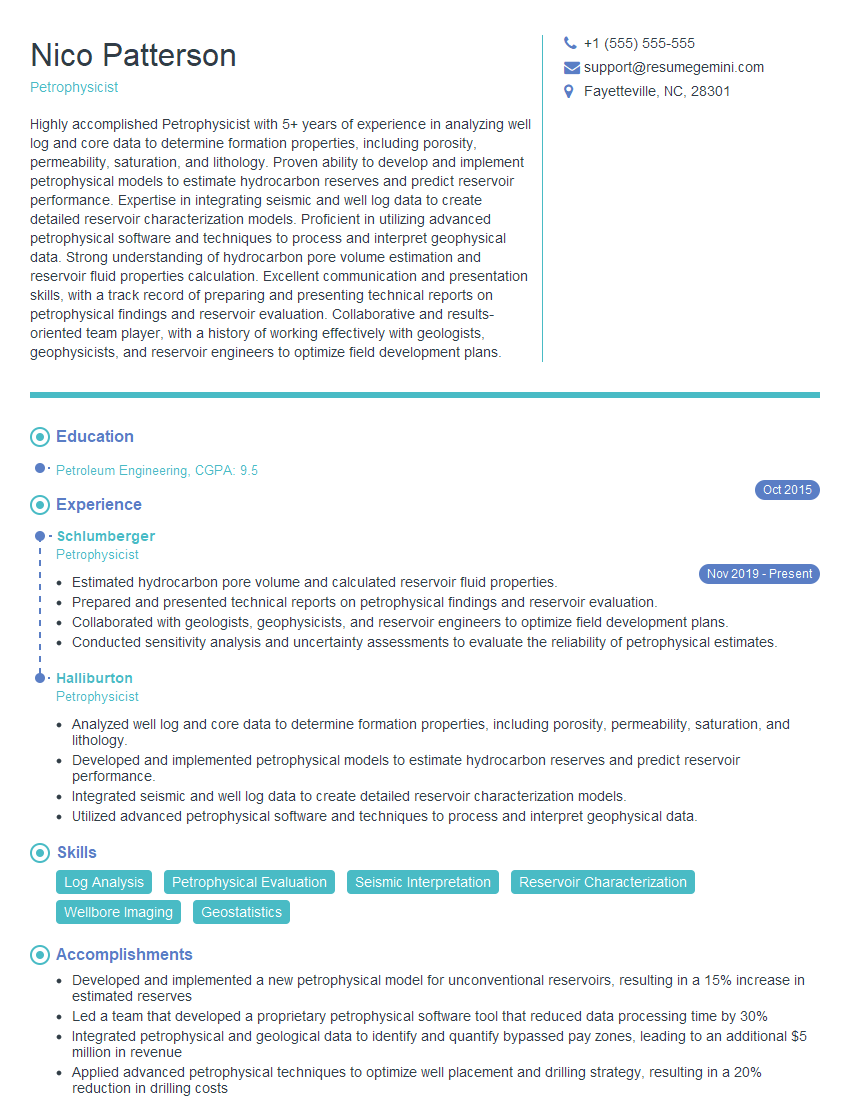Unlock your full potential by mastering the most common Exploration and Development Planning interview questions. This blog offers a deep dive into the critical topics, ensuring you’re not only prepared to answer but to excel. With these insights, you’ll approach your interview with clarity and confidence.
Questions Asked in Exploration and Development Planning Interview
Q 1. Explain the difference between exploration and development geology.
Exploration geology focuses on discovering new hydrocarbon accumulations, while development geology focuses on optimizing production from already discovered reservoirs. Think of it like this: exploration is finding the treasure, while development is efficiently extracting it.
Exploration Geology involves techniques like seismic surveys, geological mapping, and geochemical analysis to identify potential hydrocarbon traps. The goal is to assess the potential for hydrocarbons, often with significant uncertainty. A successful exploration program might lead to the drilling of an appraisal well to confirm the discovery.
Development Geology, on the other hand, uses detailed geological data obtained from wells (such as core samples, logs, and production tests) to understand the reservoir’s characteristics: porosity, permeability, fluid saturation, and geometry. This information is crucial for planning efficient drilling, completion, and production strategies. The focus shifts from finding hydrocarbons to understanding and maximizing their extraction.
In short: Exploration answers ‘Where are the hydrocarbons?’, while development answers ‘How do we best extract them?’
Q 2. Describe your experience with geological modeling software.
I have extensive experience with several industry-standard geological modeling software packages, including Petrel, RMS, and Kingdom. My expertise encompasses building static and dynamic models, encompassing reservoir characterization, history matching, and forecasting.
For example, in a recent project involving a carbonate reservoir, I utilized Petrel to integrate seismic data, well logs, and core analysis to create a 3D geological model. This model was subsequently used to define reservoir compartments, predict fluid flow, and optimize well placement, ultimately leading to a 15% increase in projected production. I am proficient in using these tools to build and refine models, ensuring they accurately reflect the subsurface geology and facilitate informed decision-making throughout the lifecycle of a project, from exploration to production optimization. My experience includes both structural and stratigraphic modeling, with a focus on ensuring geological realism and uncertainty quantification.
Q 3. How do you assess the economic viability of an exploration prospect?
Assessing the economic viability of an exploration prospect is a complex process that involves a thorough evaluation of various factors. It’s essentially a risk-reward assessment.
- Resource estimation: This involves determining the volume and quality of hydrocarbons potentially present (using techniques like volumetric calculations or reserves estimation).
- Cost estimation: A detailed breakdown of exploration, appraisal, and development costs is needed, including drilling, seismic surveys, and infrastructure development.
- Revenue forecasting: Projecting future hydrocarbon prices and production rates is essential to estimate potential revenue streams.
- Economic analysis: This involves calculating key metrics such as Net Present Value (NPV), Internal Rate of Return (IRR), and Payback Period to assess the profitability of the project under various scenarios. Sensitivity analysis is crucial to understand the impact of uncertainty in key parameters like oil price and production rates.
- Risk assessment: Identifying and quantifying geological, technical, and economic risks is crucial for making informed decisions. This often involves probabilistic assessments and Monte Carlo simulations.
In practice, we use specialized software and economic models to perform these analyses. The final decision hinges on whether the expected return justifies the inherent risks and investment costs. A high NPV and a low risk profile generally indicate a viable prospect.
Q 4. What are the key factors influencing reservoir simulation?
Reservoir simulation is a powerful tool for predicting reservoir performance, but its accuracy depends heavily on several key factors:
- Geological model: The quality of the input geological model, including its geometry, petrophysical properties, and fluid distribution, directly impacts the simulation results. Inaccuracies in this model can lead to significant errors in predictions.
- Fluid properties: Accurate representation of fluid properties, such as viscosity, density, and composition, is crucial, especially in complex reservoirs with multiple fluid phases.
- Rock properties: Parameters like porosity, permeability, and capillary pressure, which govern fluid flow, need to be precisely defined. Heterogeneities in these properties can significantly influence simulation outcomes.
- Numerical techniques: The choice of numerical methods used to solve the governing equations can affect both the accuracy and computational cost of the simulation. Careful selection is vital for efficient and reliable results.
- Boundary conditions: Defining appropriate boundary conditions, which represent the reservoir’s interaction with its surroundings, is essential. Incorrect boundary conditions can lead to unrealistic predictions.
- Well models: Accurate representation of well performance, including completion type, inflow/outflow profiles, and wellbore pressure, is necessary for realistic simulations.
Essentially, the accuracy of a reservoir simulation is only as good as the quality of its input data and the sophistication of the numerical methods employed. Regular model calibration and validation are essential to ensure reliability.
Q 5. Explain the process of well planning and completion.
Well planning and completion are crucial stages in hydrocarbon extraction, each involving a series of carefully planned steps.
Well Planning: This begins with defining the well’s objective, such as exploration, appraisal, or development. Geological data, seismic interpretations, and reservoir simulations are used to determine the optimal well location, trajectory, and design. Factors considered include minimizing drilling risks, maximizing hydrocarbon recovery, and ensuring well integrity. Detailed engineering analyses are carried out to design the wellbore and select appropriate drilling equipment and techniques. Safety is paramount throughout the entire planning process.
Well Completion: Once the well is drilled, completion operations begin to equip the well for production or injection. This involves installing various components to control fluid flow, such as casing, cement, perforations, and artificial lift systems (like pumps). The completion design is tailored to the specific reservoir characteristics and production strategy. The choice of completion method greatly influences the long-term productivity and efficiency of the well. A successful completion ensures the safe and efficient production of hydrocarbons over the well’s lifetime.
In essence, well planning is about strategically positioning the well, while well completion is about optimizing its production.
Q 6. How do you evaluate the risk associated with an exploration project?
Evaluating risk in exploration projects requires a multi-faceted approach, considering geological, technical, and economic uncertainties.
- Geological risk: This includes uncertainty about the presence, size, and quality of the hydrocarbon reservoir. Techniques like probabilistic resource estimation and geological modeling help quantify this risk.
- Technical risk: This encompasses challenges related to drilling, completion, and production. Factors such as drilling difficulties, reservoir heterogeneity, and equipment failure are assessed.
- Economic risk: This involves uncertainties in oil/gas prices, operating costs, and project financing. Sensitivity analysis and Monte Carlo simulations help understand the impact of these factors on project profitability.
- Regulatory and political risk: This includes considerations such as permitting processes, environmental regulations, and political stability in the operating region.
A comprehensive risk assessment typically involves a combination of qualitative and quantitative techniques. Qualitative methods, such as expert judgment and hazard identification, help identify potential risks, while quantitative methods, such as probabilistic analysis and Monte Carlo simulation, help quantify their impact and likelihood. The results are often presented as a risk matrix or heat map, visually representing the severity and probability of different risks. This enables informed decision-making, allowing companies to mitigate risks and optimize exploration strategies.
Q 7. Describe your experience with seismic data interpretation.
My experience with seismic data interpretation spans various techniques and applications. I am proficient in processing and interpreting 2D and 3D seismic data to identify structural and stratigraphic features relevant to hydrocarbon exploration.
I routinely use specialized software like Petrel and Kingdom to perform tasks such as: horizon picking, fault interpretation, attribute analysis, and seismic inversion. For instance, in one project, I used pre-stack depth migration data to image a complex fault system within a deepwater prospect, which enabled the identification of a previously unrecognized structural trap. My expertise involves understanding the limitations and uncertainties associated with seismic data interpretation and integrating it effectively with other geological and geophysical data. Seismic interpretation is a critical step in exploration, informing well placement and ultimately reducing exploration risk.
Q 8. How do you integrate geological, geophysical, and petrophysical data?
Integrating geological, geophysical, and petrophysical data is crucial for building a comprehensive subsurface model. It’s like assembling a 3D puzzle of the reservoir. Geological data provides the framework – the rock types, their ages, and structural features (faults, folds) – obtained from outcrops, well logs, and seismic interpretations. Geophysical data, primarily from seismic surveys, gives a large-scale image of the subsurface structure and potential hydrocarbon traps. Petrophysical data, derived from well logs, provides information about the rock’s properties at a smaller scale – porosity, permeability, water saturation, and hydrocarbon type.
The integration process often involves:
- Seismic Interpretation: Identifying potential reservoir intervals and structural features from seismic data.
- Well Log Analysis: Determining reservoir properties such as porosity, permeability, and hydrocarbon saturation from well logs.
- Geological Modeling: Creating a 3D geological model that integrates the seismic interpretation and well log data to define the reservoir geometry and properties.
- Geostatistical Analysis: Using statistical techniques to estimate reservoir properties in areas where data is sparse.
- Rock Physics Modeling: Relating seismic attributes to petrophysical properties to improve the accuracy of the reservoir model.
For example, we might use seismic data to identify a potential reservoir structure, then use well logs from a nearby well to calibrate the seismic data and estimate properties like porosity and permeability across the entire structure. This integrated approach significantly reduces uncertainty in reservoir characterization and aids in optimizing development strategies.
Q 9. What are the different types of reservoir drive mechanisms?
Reservoir drive mechanisms are the forces that push hydrocarbons out of the reservoir rock and into the production well. Think of it like squeezing a sponge – the mechanism is what does the squeezing. There are several types:
- Solution Gas Drive: As pressure drops, dissolved gas in the oil comes out of solution, expanding and pushing the oil. This is common in many reservoirs.
- Gas Cap Drive: A gas cap above the oil expands as pressure decreases, pushing the oil downwards and towards the well. This is a highly efficient mechanism.
- Water Drive: Water encroaches into the reservoir, displacing oil towards the well. This can be a very effective drive mechanism for long-term production.
- Combination Drive: Many reservoirs experience a combination of the above mechanisms, each contributing at different stages of production.
- Gravity Drainage: In reservoirs with significant vertical variation in fluid density (oil on top of water), gravity helps drain the oil towards the well.
Understanding the dominant drive mechanism is critical for accurate reservoir simulation and production forecasting. For instance, a reservoir primarily driven by solution gas might exhibit a rapid pressure decline, while a water-drive reservoir might have a more sustained production rate.
Q 10. How do you optimize production from a mature reservoir?
Optimizing production from a mature reservoir involves maximizing remaining reserves and extending the life of the field. It’s about getting the most out of what’s left. This often necessitates a multi-pronged approach:
- Improved Water Management: Optimizing water injection strategies to maintain reservoir pressure and sweep efficiency. This might involve re-evaluating injection well locations or rates.
- Enhanced Oil Recovery (EOR) Techniques: Implementing EOR methods to recover additional oil that would otherwise remain trapped. This could range from simple gas injection to more complex chemical or thermal processes.
- Reservoir Surveillance: Using advanced monitoring technologies (e.g., permanent downhole gauges, 4D seismic) to track reservoir performance and identify areas for improvement. Think of this as constantly monitoring the “health” of the reservoir.
- Well Intervention: Performing operations like acidizing or fracturing to improve well productivity in underperforming wells. This is like unclogging a pipe to improve flow.
- Data Analytics and Machine Learning: Leveraging advanced data analytics to identify patterns and optimize production strategies. Machine learning models can help predict future production, optimize well control, and improve reservoir management.
A successful optimization strategy requires a detailed understanding of the reservoir’s current state, the remaining resources, and the limitations of the existing infrastructure. A phased approach, prioritizing the most cost-effective and impactful interventions, is usually recommended.
Q 11. Explain your understanding of enhanced oil recovery (EOR) techniques.
Enhanced Oil Recovery (EOR) techniques aim to improve oil recovery beyond what can be achieved with primary and secondary recovery methods. These are advanced techniques used when primary and secondary methods are insufficient. Think of it as adding extra tools to your toolkit to get the last bit of oil out.
EOR techniques can be broadly classified into:
- Gas Injection (Miscible and Immiscible): Injecting gases like CO2, nitrogen, or natural gas into the reservoir to improve oil mobility.
- Waterflooding (Improved Waterflooding): Advanced water injection strategies to enhance sweep efficiency and displacement of oil.
- Chemical EOR: Using chemicals such as polymers, surfactants, or alkalis to alter the properties of oil and water, thereby increasing oil recovery.
- Thermal EOR: Using heat to reduce oil viscosity and improve mobility. Methods include steam injection, in-situ combustion, and cyclic steam stimulation.
The selection of the most appropriate EOR technique depends on several factors, including reservoir characteristics (rock type, oil properties, temperature, pressure), economic considerations, and environmental regulations. For instance, steam injection might be suitable for heavy oil reservoirs, while CO2 injection might be more efficient for lighter oils.
Q 12. Describe your experience with reservoir simulation software.
I have extensive experience with various reservoir simulation software packages, including CMG (Computer Modelling Group) STARS, Eclipse, and Petrel. These platforms provide powerful tools for building complex reservoir models, simulating fluid flow, and predicting production performance. My proficiency encompasses:
- Building reservoir models: Defining reservoir geometry, properties, and fluid properties.
- History matching: Calibrating the model to match historical production data.
- Forecasting production: Predicting future production under different scenarios.
- Sensitivity analysis: Evaluating the impact of uncertainties on production forecasts.
- Optimization studies: Investigating different development strategies to optimize oil recovery.
For example, in a recent project, we used CMG STARS to simulate the impact of CO2 injection on oil recovery in a carbonate reservoir. The simulation results helped optimize the injection strategy, leading to a significant increase in the projected ultimate recovery. My skills also include using these tools to analyze and interpret results, making them relevant and actionable for decision-making. Beyond technical proficiency, I understand the limitations of simulation and the importance of validating results with field data.
Q 13. How do you manage uncertainty in exploration and development projects?
Uncertainty is inherent in exploration and development projects. It’s like navigating a fog – you have some visibility, but not a perfect picture. Managing uncertainty requires a systematic approach:
- Probabilistic Modeling: Using Monte Carlo simulations or other probabilistic methods to quantify uncertainty in reservoir parameters (e.g., porosity, permeability, oil saturation). This helps understand the range of possible outcomes.
- Risk Assessment: Identifying and assessing potential risks, such as geological uncertainties, operational challenges, and price fluctuations. This involves quantifying the likelihood and potential impact of each risk.
- Sensitivity Analysis: Determining the sensitivity of project economics to key parameters. This helps prioritize data acquisition or risk mitigation efforts.
- Decision Analysis: Using decision trees or other decision-making frameworks to evaluate different development options under uncertainty. This might include scenarios such as “drill or not drill” or “develop with or without EOR”.
- Contingency Planning: Developing plans to address potential problems and mitigate risks. This might include having backup plans or establishing financial buffers.
In practice, we use a combination of these techniques to develop a robust and well-informed decision-making framework. This ensures that we make the best possible decisions despite the inherent uncertainty of subsurface exploration and development.
Q 14. What are the key performance indicators (KPIs) for exploration and development projects?
Key Performance Indicators (KPIs) for exploration and development projects are crucial for tracking progress and evaluating success. They act like checkpoints on a long journey, ensuring you’re on track. KPIs can vary based on the stage of the project and company objectives but commonly include:
- Drilling Success Rate: The percentage of wells that encounter commercial hydrocarbon reserves.
- Finding and Development Cost: The cost per barrel of oil or gas discovered and developed.
- Production Rate: The volume of hydrocarbons produced per day or year.
- Recovery Factor: The percentage of hydrocarbons in place that are successfully recovered.
- Return on Investment (ROI): The profitability of the project, considering all costs and revenues.
- Net Present Value (NPV): The present value of all future cash flows, discounted to account for the time value of money.
- Health, Safety, and Environment (HSE) Performance: Metrics related to safety incidents, environmental impact, and regulatory compliance.
Regular monitoring of these KPIs is crucial for identifying potential problems early on and adjusting strategies as needed. It’s important to remember that the relative importance of different KPIs might change throughout the project lifecycle.
Q 15. Describe your experience with project management methodologies.
Throughout my career, I’ve extensively utilized various project management methodologies, adapting my approach based on project specifics and team dynamics. I’m proficient in Agile, Waterfall, and hybrid approaches. For instance, in a recent exploration project involving multiple wells in a complex geological setting, we adopted an Agile methodology. This allowed for iterative development, enabling us to incorporate real-time data from early wells into the planning and execution of subsequent ones. This flexibility proved crucial in mitigating unforeseen geological challenges and optimizing resource allocation. In contrast, a large-scale field development project benefitted from a more structured Waterfall approach, ensuring a robust, pre-planned execution process and meticulous documentation for regulatory compliance. My experience also encompasses the use of project management tools such as MS Project and Primavera P6 for scheduling, resource allocation, and risk management.
I believe the key to successful project management lies in selecting the right methodology and tools for the task at hand, coupled with strong communication and collaboration within the team.
Career Expert Tips:
- Ace those interviews! Prepare effectively by reviewing the Top 50 Most Common Interview Questions on ResumeGemini.
- Navigate your job search with confidence! Explore a wide range of Career Tips on ResumeGemini. Learn about common challenges and recommendations to overcome them.
- Craft the perfect resume! Master the Art of Resume Writing with ResumeGemini’s guide. Showcase your unique qualifications and achievements effectively.
- Don’t miss out on holiday savings! Build your dream resume with ResumeGemini’s ATS optimized templates.
Q 16. How do you handle conflicting priorities in an E&D project?
Conflicting priorities are an inevitable reality in E&D projects, often arising from competing demands on budget, schedule, safety, and environmental considerations. My approach involves a structured prioritization process. First, I clearly define project objectives and deliverables, establishing a baseline against which to measure progress. Next, I utilize tools such as a Prioritization Matrix, assigning weights to each priority based on its impact on overall project goals and risks associated with delays or compromises. This matrix helps visualize trade-offs. For example, if a geological uncertainty necessitates additional investigations, potentially delaying the project, I’ll assess the risk of proceeding without sufficient data versus the cost and time implications of further investigation. This analysis informs decision-making, balancing competing priorities transparently and collaboratively with stakeholders.
Open communication and stakeholder engagement are crucial throughout this process. Regular progress reviews and transparent communication of any compromises help maintain buy-in from all parties.
Q 17. How do you ensure the safety and environmental compliance of E&D operations?
Safety and environmental compliance are paramount in E&D operations. My approach is proactive and integrates safety and environmental considerations into every stage of the project lifecycle, from initial planning through execution and decommissioning. We develop comprehensive safety and environmental management plans that comply with all relevant regulations, incorporating best practices and lessons learned from previous projects. These plans are reviewed and updated regularly to reflect evolving best practices and emerging regulations.
We utilize a multi-layered approach, including regular safety audits and environmental monitoring, thorough risk assessments (covering aspects like well control, blowout prevention, and waste management), and robust emergency response plans. Employee training and ongoing safety awareness programs are vital, emphasizing both individual responsibility and collective accountability. For example, before any drilling operation begins, a detailed pre-job safety analysis (JSA) is carried out to identify and mitigate potential hazards. Furthermore, all our environmental impact assessments (EIAs) undergo rigorous review to ensure we minimize our footprint and actively mitigate any potential adverse effects on local ecosystems.
Q 18. What is your experience with well testing and analysis?
I have extensive experience in well testing and analysis, encompassing various testing methodologies such as pressure buildup tests, drawdown tests, and multi-rate tests. I’m proficient in interpreting test data to determine reservoir properties such as permeability, porosity, and skin factor, which are vital for accurate reservoir modeling and production forecasting. My experience involves using specialized software for data analysis, including interpretation of pressure transient data using type curves and numerical modeling. For instance, in one project, the initial well test data indicated a lower than anticipated permeability. Through detailed analysis, we identified a skin effect caused by near-wellbore damage. This crucial insight allowed us to optimize stimulation treatments and significantly improve production performance. I’m also experienced in the design and execution of well tests, ensuring the accuracy and reliability of the data obtained. Accurate well testing is fundamental to optimize production strategies and reduce economic uncertainties.
Q 19. Describe your understanding of different drilling techniques.
My understanding of drilling techniques spans various methods, including conventional rotary drilling, directional drilling, horizontal drilling, and underbalanced drilling. The choice of technique depends on factors such as reservoir characteristics, geological conditions, and project objectives. For example, in a deepwater environment with challenging geological conditions, directional or horizontal drilling might be employed to reach multiple reservoir targets from a single platform, optimizing cost and minimizing environmental impact. Conversely, conventional rotary drilling might suffice for shallower, simpler geological formations. I’m familiar with the equipment and processes involved in each technique, including bit selection, mud systems, and wellbore stability management. I understand the trade-offs between different techniques regarding cost, efficiency, and risk. Underbalanced drilling, for instance, can mitigate formation damage but carries the risk of increased wellbore instability. A thorough understanding of these factors is critical for efficient and safe well construction.
Q 20. Explain the concept of a geological risk assessment.
A geological risk assessment is a systematic process to identify, analyze, and evaluate potential geological uncertainties that could impact the success of an E&D project. It involves a thorough review of available geological data, including seismic surveys, well logs, core data, and other subsurface information. This data is used to create a geological model, which is then used to quantify the uncertainty associated with key reservoir parameters. For example, uncertainties might include the reservoir’s size, shape, permeability, and the presence of faults or fractures.
The assessment typically involves probabilistic modeling, incorporating various scenarios and their associated probabilities to assess the potential impact of these uncertainties on key project parameters such as reserves, production rates, and project economics. The output of a geological risk assessment is often presented in the form of probability distributions, allowing decision-makers to understand the range of possible outcomes and associated risks.
Q 21. How do you evaluate the potential impact of regulatory changes on an E&D project?
Evaluating the potential impact of regulatory changes is a crucial aspect of E&D project management. This involves monitoring changes in environmental regulations, safety standards, and permitting requirements at both national and international levels. For example, changes in emission standards or regulations on waste disposal could significantly affect project costs and operational procedures. I approach this by establishing a formal regulatory monitoring system, tracking relevant changes and their potential impacts on the project. This involves regular reviews of relevant legislation, engagement with regulatory agencies, and scenario planning to evaluate potential impacts under different regulatory scenarios.
The process involves quantifying the potential financial and operational implications of regulatory changes, factoring them into project budgets and schedules, and developing contingency plans to address potential challenges. Open communication with regulatory agencies is crucial in understanding regulatory expectations and securing necessary permits and approvals. Adaptability and proactive engagement are key to ensuring regulatory compliance and minimizing disruptions to the project.
Q 22. How do you communicate complex technical information to non-technical audiences?
Communicating complex technical information to non-technical audiences requires a shift in perspective. Instead of focusing on jargon and intricate details, the key is to translate complex concepts into easily understandable terms using analogies, visual aids, and storytelling.
For instance, explaining reservoir pressure to a non-technical stakeholder, I wouldn’t use terms like ‘hydrostatic pressure gradient’. Instead, I would use an analogy like ‘imagine a water balloon – the pressure inside is like the reservoir pressure; the more water, the higher the pressure, and that pressure drives the flow of oil and gas.’
I also utilize visual aids like charts and diagrams to represent data effectively. A simple pie chart showing the percentage breakdown of project costs or a flowchart illustrating the stages of exploration is far more effective than a lengthy technical report. Finally, storytelling can humanize complex processes. Sharing anecdotes about successful projects or challenges encountered helps people relate to the information on a personal level, making it more memorable.
Q 23. What are the ethical considerations involved in exploration and development?
Ethical considerations in exploration and development are paramount. We are dealing with finite resources and impacting delicate ecosystems. Environmental protection is central, requiring careful assessment of potential impacts, adherence to strict regulations (like those concerning methane emissions or waste disposal), and implementation of mitigation strategies. We must prioritize minimizing the environmental footprint through techniques like carbon capture and responsible waste management.
Another key aspect is social responsibility. Engaging local communities, respecting their rights, and ensuring transparent communication about project plans and potential impacts are critical. Fair compensation for land use and creating employment opportunities within the community are ethical obligations. Transparency in operations, including data sharing and environmental reporting, builds trust and accountability.
Ultimately, ethical considerations guide decision-making throughout the entire lifecycle of an E&D project. It’s not just about compliance but about operating with integrity, minimizing risks, and ensuring sustainable development for both the environment and society.
Q 24. Describe a challenging E&D project you worked on and how you overcame it.
One particularly challenging project involved developing a deepwater oil field in a geologically complex area with unpredictable reservoir behavior. Initial production forecasts were significantly overestimated due to uncertainties in reservoir characterization. This led to substantial cost overruns and threatened the project’s viability.
To overcome this, I implemented a multi-faceted approach. First, we assembled a team of experts in reservoir simulation, geophysics, and drilling engineering to re-evaluate the reservoir model using advanced data analytics techniques, including machine learning. This allowed us to develop a more accurate prediction of reservoir performance. Second, we implemented a phased development strategy, focusing on less risky areas initially and scaling up production based on real-time data. This minimized the financial risk and allowed for adaptive management of the project.
Finally, we fostered open communication and collaboration among all stakeholders. Regular progress reports and transparent communication with investors helped manage expectations and build confidence in our ability to overcome the challenges. Through this concerted effort, we successfully recovered the project, delivering respectable production while minimizing environmental and financial risks.
Q 25. How do you stay up to date with the latest advances in E&D technologies?
Staying current in E&D requires a multi-pronged approach. I regularly attend industry conferences and workshops like those hosted by the SPE (Society of Petroleum Engineers), where I network with peers and learn about cutting-edge techniques. I actively subscribe to industry publications and journals, including OnePetro and various scientific magazines, to keep abreast of the latest research findings and technological advancements.
Online resources such as SPE’s OnePetro database and reputable industry websites provide access to technical papers and case studies. I also actively participate in online communities and forums where experts share experiences and knowledge. Further, I regularly explore new software and technology demonstrations relevant to seismic imaging, reservoir simulation, and drilling optimization. Continuous learning is key, and leveraging these different avenues ensures I remain proficient in the latest advancements.
Q 26. What are your salary expectations?
My salary expectations are in line with the industry standards for a domain expert with my experience and qualifications. Given my expertise in exploration and development planning, particularly in challenging environments, I am confident my contributions would be valuable. I am open to discussing a specific salary range after learning more about the comprehensive compensation package offered by the company, including benefits and growth opportunities.
Q 27. What are your career goals?
My career goals are focused on continued growth and contribution within the energy sector. I aspire to lead increasingly complex E&D projects, taking on greater responsibility and mentorship roles. I am keen to leverage my expertise in sustainable and responsible resource management to contribute to the energy transition. I see myself potentially leading teams dedicated to developing innovative solutions for efficient and environmentally friendly energy production. Ultimately, my goal is to make a significant and positive impact on the industry while continuously developing my own expertise and leadership abilities.
Key Topics to Learn for Exploration and Development Planning Interview
- Resource Assessment: Understanding techniques for evaluating the size and quality of potential reserves, including geological modeling and data analysis. Practical application: Interpreting seismic data to define reservoir boundaries and estimate hydrocarbon volumes.
- Drilling and Completion Strategies: Developing optimized drilling plans considering factors like well placement, trajectory, and completion techniques. Practical application: Analyzing well cost estimates and optimizing well designs to minimize risk and maximize production.
- Production Forecasting and Optimization: Developing accurate production forecasts using reservoir simulation and decline curve analysis. Practical application: Using forecasting models to inform investment decisions and optimize production strategies.
- Project Economics and Risk Management: Evaluating the economic viability of exploration and development projects, including cost estimation, revenue forecasting, and risk assessment. Practical application: Performing sensitivity analysis on key project parameters to identify potential risks and opportunities.
- Environmental Considerations and Regulations: Understanding and adhering to environmental regulations related to exploration and development activities. Practical application: Developing mitigation plans to minimize the environmental impact of projects.
- Data Management and Integration: Utilizing various data sources (geological, geophysical, engineering) to create a comprehensive understanding of the reservoir. Practical application: Building and maintaining a robust data management system to support decision-making.
- Health, Safety, and Environmental (HSE) Management: Implementing and enforcing HSE procedures to ensure a safe working environment. Practical application: Developing and implementing emergency response plans.
Next Steps
Mastering Exploration and Development Planning is crucial for advancing your career in the energy sector. It demonstrates a strong understanding of the technical and economic aspects of project development, making you a highly valuable asset to any team. To significantly enhance your job prospects, creating an ATS-friendly resume is essential. This ensures your qualifications are effectively conveyed to potential employers. We highly recommend using ResumeGemini to build a professional and impactful resume. ResumeGemini offers a user-friendly interface and provides examples of resumes tailored to Exploration and Development Planning, ensuring your application stands out from the competition.
Explore more articles
Users Rating of Our Blogs
Share Your Experience
We value your feedback! Please rate our content and share your thoughts (optional).
What Readers Say About Our Blog
This was kind of a unique content I found around the specialized skills. Very helpful questions and good detailed answers.
Very Helpful blog, thank you Interviewgemini team.
